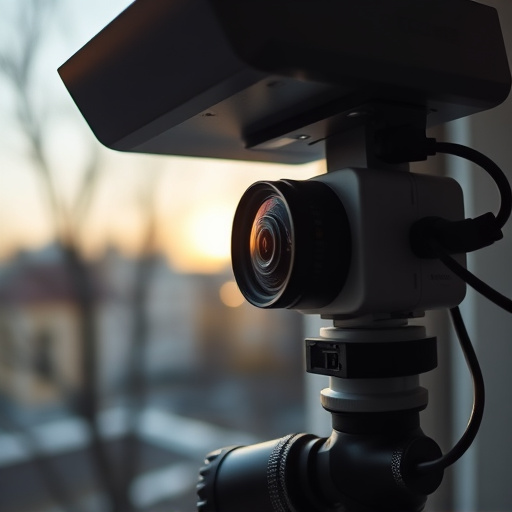Battery-powered wireless spy cameras, popular for remote monitoring and stealthy design, raise privacy concerns. Legal and ethical considerations require explicit consent and respect for privacy rights. Proper placement, detection techniques, and security measures are crucial to avoid legal risks and invasion of privacy. Strategic deployment, infrared technology, firmware updates, and encryption enhance surveillance while preserving secrecy.
In the realm of surveillance, covert recording equipment plays a pivotal role in gathering intelligence or ensuring security. This article delves into the intricacies of battery-powered wireless spy cameras, exploring their understanding, ethical considerations for placement, detection techniques, legal implications, and best practices for secure setup. With these insights, folks can navigate the labyrinthine world of hidden cameras, fostering a safer and more transparent environment.
- Understanding Battery-Powered Wireless Spy Cameras
- Ethical Considerations for Equipment Placement
- Uncovering Hidden Cameras: Detection Techniques
- Legal Implications of Covert Recording Devices
- Best Practices for Secure Surveillance Setup
Understanding Battery-Powered Wireless Spy Cameras
Battery-powered wireless spy cameras have become increasingly popular due to their convenience and hidden nature. These compact devices operate autonomously, drawing power from rechargeable batteries, allowing them to be placed in various locations without the need for an external power source. Their wireless connectivity enables remote monitoring via a connected app, offering users real-time access and control from virtually anywhere.
One of the key advantages is their stealthy operation. The devices can be easily hidden away in everyday objects like plants, light fixtures, or even wall-mounted picture frames, making them ideal for surveillance purposes. With advanced features such as motion detection, night vision, and HD video quality, these spy cameras capture detailed footage without compromising on privacy and security.
Ethical Considerations for Equipment Placement
When placing covert recording equipment, such as battery-powered wireless spy cameras, ethical boundaries must be carefully considered to ensure legal and moral compliance. The use of hidden cameras raises significant privacy concerns, especially in public spaces or private properties without explicit consent. It is essential to respect individuals’ right to privacy and only deploy such devices where there is a legitimate need and appropriate authorization.
For instance, in business settings, installing covert cameras might aid in security measures, but employers should be transparent about surveillance practices and ensure employees are aware of their monitoring. In contrast, personal use cases, like monitoring pets or children’s activities, require a different ethical approach, as long as the subject is informed and not significantly invaded upon. Proper placement ensures that recordings capture specific areas of interest without becoming an intrusive force in people’s lives.
Uncovering Hidden Cameras: Detection Techniques
Uncovering hidden cameras, particularly battery-powered wireless spy cameras, requires a blend of technical expertise and keen observation. These compact devices can be nearly invisible, integrated into everyday objects like clocks, pens, or even light switches. Detecting them demands a systematic approach. One method involves using specialized UV lights, which can reveal the presence of infrared LEDs commonly used in covert cameras. Additionally, thermal imaging technology is highly effective; heat signatures from the camera’s components often stand out against surrounding objects.
Another powerful technique is electromagnetic frequency (EMF) detection. Spy cameras, especially wireless ones, emit specific EMF signals. Skilled investigators can employ EMF detectors to pinpoint these emissions, leading them directly to the hidden device. Combining these methods ensures a thorough search for battery-powered wireless spy cameras, underscoring the importance of staying vigilant in today’s digital era.
Legal Implications of Covert Recording Devices
The use of covert recording equipment, such as battery-powered wireless spy cameras, comes with a range of legal implications that must be carefully considered. In many jurisdictions, the placement and use of such devices are subject to strict regulations aimed at protecting privacy rights. Unauthorized installation or operation of these gadgets can result in severe legal consequences, including fines and imprisonment.
It’s crucial for individuals or organizations employing covert recording devices to understand the laws specific to their region. Misuse of these tools can lead to civil lawsuits for invasion of privacy, with victims potentially seeking damages. Additionally, law enforcement agencies have specialized units dedicated to detecting and investigating hidden cameras, further complicating matters for those engaging in illegal surveillance activities.
Best Practices for Secure Surveillance Setup
When setting up a surveillance system with battery-powered wireless spy cameras, security professionals recommend adhering to best practices for optimal results and minimal detection risks. One crucial aspect is to strategically place the cameras in hidden locations that are naturally out of view. This might involve mounting them on ceilings, behind furniture, or inside everyday objects like plants or picture frames. Additionally, utilizing infrared technology ensures effective night vision without drawing attention.
To maintain a secure setup, regular checks and updates are essential. Keep the camera’s firmware up-to-date to prevent any vulnerabilities that could be exploited. Ensure wireless networks are secured with strong encryption protocols. Furthermore, consider implementing motion detection features to record only when activity is detected, enhancing privacy and saving storage space. Regularly changing battery and memory card locations adds an extra layer of security.
Covert recording equipment, particularly battery-powered wireless spy cameras, presents a complex interplay between security needs and privacy rights. Understanding the technology, such as these cameras’ unique battery and wireless capabilities, is crucial for both users and regulators. Ethical considerations and legal implications must guide responsible placement and use to ensure respect for personal privacy while fostering secure environments. By adhering to best practices, including thorough detection techniques, individuals can navigate this digital landscape confidently, knowing their spaces remain safe yet free from the unseen intrusion of covert recording devices.
